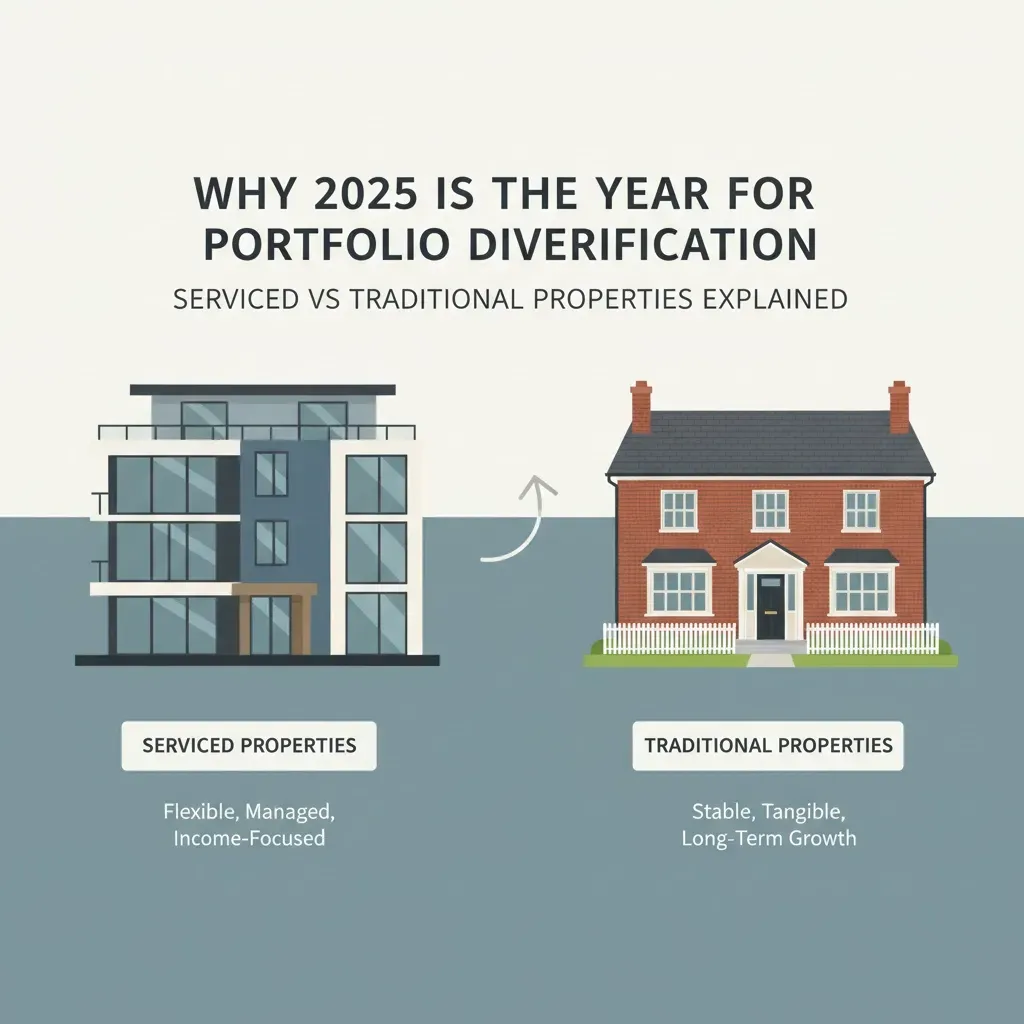
Why 2025 Is the Year for Portfolio Diversification: Serviced vs Traditional Properties Explained
If you're a UK landlord still relying solely on traditional long-term rentals, 2025 might be the wake-up call you need. The property investment landscape has shifted dramatically, and smart investors are already diversifying their portfolios to include short-term rentals alongside their traditional lets. Here's why this year presents the perfect storm of opportunities for portfolio diversification: and why serviced apartments could be your ticket to higher returns.
The Market Reality Check: Why Traditional Rentals Aren't Enough Anymore
Let's be honest: the traditional rental market has become increasingly challenging. With rising mortgage rates, stricter regulations, and tenant-friendly policies that can leave landlords vulnerable to extended void periods, relying on just one rental strategy feels a bit like putting all your eggs in one basket.
The economic volatility we're seeing in 2025 has made diversification not just smart, but essential. While traditional rentals offer steady income, they're also subject to rent caps, lengthy notice periods for possession, and the risk of problematic tenants who can cost thousands in lost rent and property damage.

Meanwhile, the short-term rental market has matured into a legitimate, profitable alternative that many landlords are now treating as a serious investment strategy rather than a side hustle. The numbers don't lie: properties optimized for short-term lets often achieve 20-40% higher gross yields compared to traditional rentals, especially in high-demand areas.
Understanding the Serviced Apartment Advantage
Serviced apartments and short-term rentals operate on fundamentally different principles than traditional lets. Instead of locking in one tenant for 12 months at a fixed rate, you're essentially running a small hospitality business that can adapt pricing based on demand, seasonality, and local events.
The key advantages include:
Dynamic Pricing Power: Unlike traditional rentals where rent reviews happen annually (if you're lucky), short-term rentals allow you to adjust rates weekly or even daily. Christmas week in London? Double your rates. Summer festival in Edinburgh? Premium pricing applies. This flexibility means you can maximize revenue during peak periods while staying competitive during quieter times.
Shorter Commitment Periods: If a guest becomes problematic, they're gone in a few days rather than requiring months of legal proceedings. This dramatically reduces your exposure to difficult occupants and property damage.
Higher Revenue Potential: Quality serviced apartments in desirable locations consistently outperform traditional rentals. We regularly see properties generating 25-35% more gross income when managed properly for short-term stays.

The 2025 Market Dynamics Favoring Short-Term Lets
Several trends converging in 2025 make this an ideal time to diversify into serviced apartments:
Remote Work Revolution: The hybrid working model has created new travel patterns. Business travelers now book longer stays (3-7 nights) in serviced apartments rather than hotels, seeking space to work and more amenities. This segment pays premium rates and treats properties with more care than typical tourists.
Leisure Travel Recovery: Post-pandemic leisure travel has rebounded strongly, but traveler preferences have shifted toward private accommodations. Families and groups prefer the space and privacy of serviced apartments over hotel rooms, creating sustained demand.
Supply and Demand Imbalance: While new hotel construction has slowed, demand for quality short-term rentals continues growing. This supply constraint means well-positioned properties can command premium rates.
Technology Integration: Modern property management systems make running short-term rentals far more efficient than even two years ago. Automated guest communication, smart locks, and integrated booking platforms have reduced the operational burden significantly.
Traditional vs Serviced: The Financial Reality
Let's get into the numbers, because that's what really matters. A typical 2-bedroom flat in Manchester might generate £1,200 per month on a traditional AST. The same property, properly set up as a serviced apartment, could achieve £150-200 per night with average occupancy of 65-75%, generating £2,900-4,600 monthly.
Even accounting for higher running costs (professional cleaning, utilities, management fees), the net income often exceeds traditional rentals by 20-40%. More importantly, you maintain control over the property and can adapt quickly to market changes.

The Risk Profile Difference: Traditional rentals carry the risk of extended void periods, tenant default, and property damage that takes months to resolve. Short-term rentals spread risk across hundreds of different guests annually, meaning one bad experience doesn't devastate your cash flow for months.
Operational Considerations: Why Professional Management Matters
Here's where many landlords get it wrong: they assume they can manage short-term rentals the same way they handle traditional lets. The reality is that serviced apartments require a completely different operational approach.
Successful short-term rental management involves:
24/7 guest communication and support
Professional photography and listing optimization
Dynamic pricing strategies that respond to market conditions
Quality assurance and regular property inspections
Seamless check-in/check-out processes
Rapid response to maintenance issues
Attempting to handle this yourself while maintaining quality standards is challenging, especially as you scale multiple properties. This is why many successful landlords partner with specialized Airbnb management companies who understand the operational complexities and can optimize performance.
The Diversification Strategy That Makes Sense
Smart portfolio diversification in 2025 doesn't mean abandoning traditional rentals entirely: it means strategically combining both models to maximize returns while minimizing risk.
Consider this approach:
Core Holdings: Maintain 60-70% of your portfolio in quality traditional rentals in solid residential areas. These provide steady, predictable income and long-term capital appreciation.
Growth Engine: Allocate 30-40% to serviced apartments in high-demand locations. These properties drive higher returns and provide flexibility to adapt to market conditions.

This balanced approach gives you the stability of traditional rentals while capturing the upside potential of short-term lets. If short-term rental regulations tighten in certain areas, you can pivot those properties back to traditional lets. Conversely, if traditional rental yields compress further, you can convert more properties to serviced apartments.
Location Strategy for Serviced Apartments
Not every property suits short-term rental conversion. The most successful serviced apartments share common characteristics:
Urban Centers: City center locations near business districts, universities, or transport hubs consistently perform well. Business travelers and short-term workers pay premium rates for convenience.
Tourist Destinations: Properties near attractions, coastlines, or in historic areas benefit from leisure travel demand and can command seasonal premiums.
Transport Links: Properties within walking distance of major train stations or airports capture both business and leisure markets.
Local Amenities: Areas with restaurants, shops, and entertainment nearby attract guests willing to pay more for the complete experience.
Getting Started: The Practical Steps
If you're considering adding serviced apartments to your portfolio, start with these steps:
Analyze Your Existing Properties: Which of your current properties could work as short-term rentals? Consider location, size, and local demand.
Research Local Regulations: Understand planning permissions, licensing requirements, and any restrictions in your target areas.
Calculate True Costs: Factor in setup costs, ongoing operational expenses, and management fees to determine realistic ROI expectations.
Partner with Experts: Work with experienced short-term rental managers who can optimize your property's performance and handle day-to-day operations.
The Bottom Line
Portfolio diversification in 2025 isn't just about spreading risk: it's about positioning yourself to capture opportunities in a rapidly evolving market. The combination of traditional and serviced rentals offers the best of both worlds: steady income from long-term lets and growth potential from short-term rentals.
The landlords who thrive in 2025 and beyond will be those who adapt their strategies to meet changing market demands while maintaining operational excellence across their entire portfolio. The question isn't whether you should diversify: it's whether you can afford not to.
Ready to explore how serviced apartments could transform your property portfolio? The opportunities are there, but they won't wait forever.
